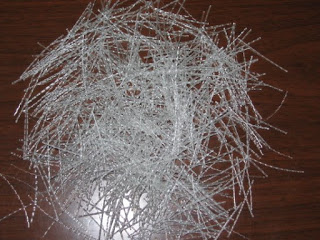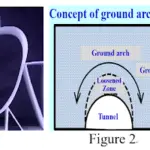We have already defined the pile foundation, its type and importance in case of low bearing ground conditions. But this post will mainly deal about the procedures and steps that are undertaken for the construction of pile foundation. Pile foundation construction procedure is not simple as it involves heavy machinery at times and requires fair assessments of the underground conditions prior to design and preliminary survey.
Pile foundation act as a steady support for structures making use of the skin friction with the ground as well as the increased bearing capacity of the soil at greater depths. We would not deal here the design of the pile foundation but would only talk about its construction procedure at site.
Construction Procedure for Bored Piling
Bore piles are commonly used to support heavily loaded structures such as high-rise buildings and bridges in view of the low noise, vibration and flexibility in size to suit different loading conditions and subsoil conditions. These vibrations are mostly attached to other conventional piling system like driven piles. The construction sequence / procedure of the bored cast in-situ piles is as follows:-
- Setting Out
- Excavation
- Placement of Reinforcement
- Concreting
- Stipping Pile Heads and Bonding
- Piling Records
Setting Out
The first and foremost step and is no doubt the most important step for carrying out piling is setting out. Generally a licensed Surveyor hired by the contractor will set up the positions of the piles which is shown in the pile layout plans of the detailed designs showing the Northing and Easting of the center of each piles along with diameters etc. The positions set out by the Surveyor are secured and preserved by pegs.
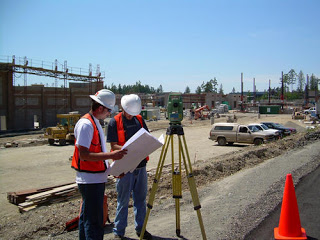 |
| Setting out (pic credit indiaMART) |
The positions of the pile are produced as-built drawings showing the position of all the piles constructed or installed. The surveyor will be checking the correct position and verticality of the pile foundation. Mostly the verticality of the finished pile from the vertical at any level is given tolerance of 1 in 150.
Contractual Submittings by the Contractor
The contractor before carrying out any physical work must submit the list of persons in charge of the supervision work for pile foundation for the approval of the Engineer. In Addition to this all the technical details manufacture comments of the piling equipment and accessories must be made along with sequence for construction of the piling work.
Excavation
The excavation of boring of the pile is carried out by auger method of boring or conventional percussion boring. In Auger cast piling procedure, a continuous flight auger drill is used to excavate a hole by screwing a hollow shaft auger into a depth of at least equal to the length of the pile.
Continuous Flight Auger (CFA) piling method is the quietest from of piling and is a fast and very economical technique. It is a cast in-situ process, very suited to soft ground where deep casings or use of drilling support fluids might otherwise be needed.
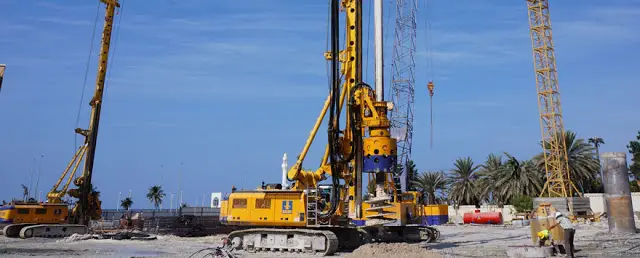 |
| Auger Piling (Pic Credit: manavinfra) |
The word auger boring can be defined as a method of boring beneath the earth’s surface by means of a jack and bore. It works by simultaneously jacking the casing pipe while the rotating augers remove the excavated soil. An auger is a drilling device, or a drill bit, that usually includes a rotating helical screw blade called a “flighting” to act as a screw conveyor to remove the drilled out material.
Percussion drilling, on the other hand, is a manual drilling technique in which a heavy cutting or hammering bit is attached to a cable which is lowered in the open hole or inside a temporary casing.
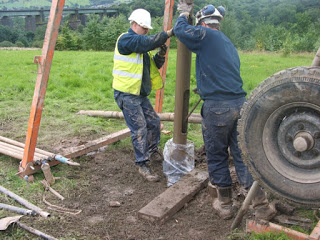 |
| Percussion Boring (Pic Credit : geositesurveys) |
Reinforcement lowering
Most of cast in-situ concrete piles are reinforced throughout its length with a cage of reinforcement fixed at ground and then lowered with the help of crane before concreting. The reinforcement usually used in pile foundation includes vertical main bars of #11 diameters with the spiral of lower dia reinforcement for providing shear and avoiding the buckling failure in the pile foundation.
The reinforcement bending schedules are first properly prepared by the contractor which is submitted to the Engineer for approval. After approval the bar bending schedule is used for cutting and fixing of the rebar at site.
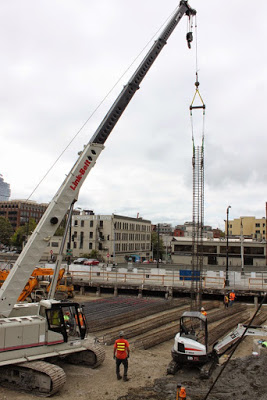 |
|
|
Concreting
The tremie method of concrete placement is used for the concrete pouring of the pile foundation. This method uses a vertical pipe, through which concrete is placed by gravity feed blow water level. The lower end of the tremie pipe is kept immersed in fresh concrete so that concrete rising from the bottom displaces the under ground water. The dia of the tremie pipe varies from 20 to 30 cm.
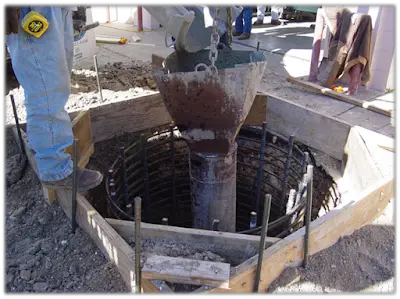 |
| Tremie Method of Concrete piling |

